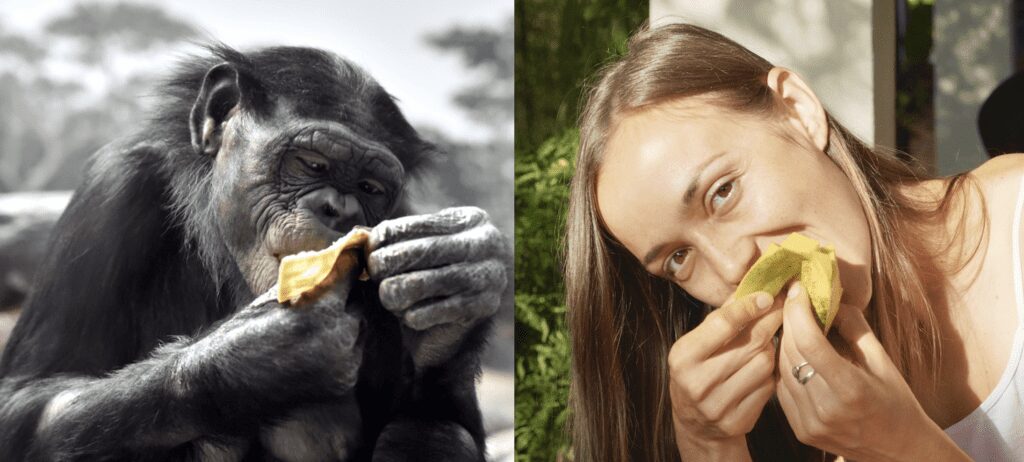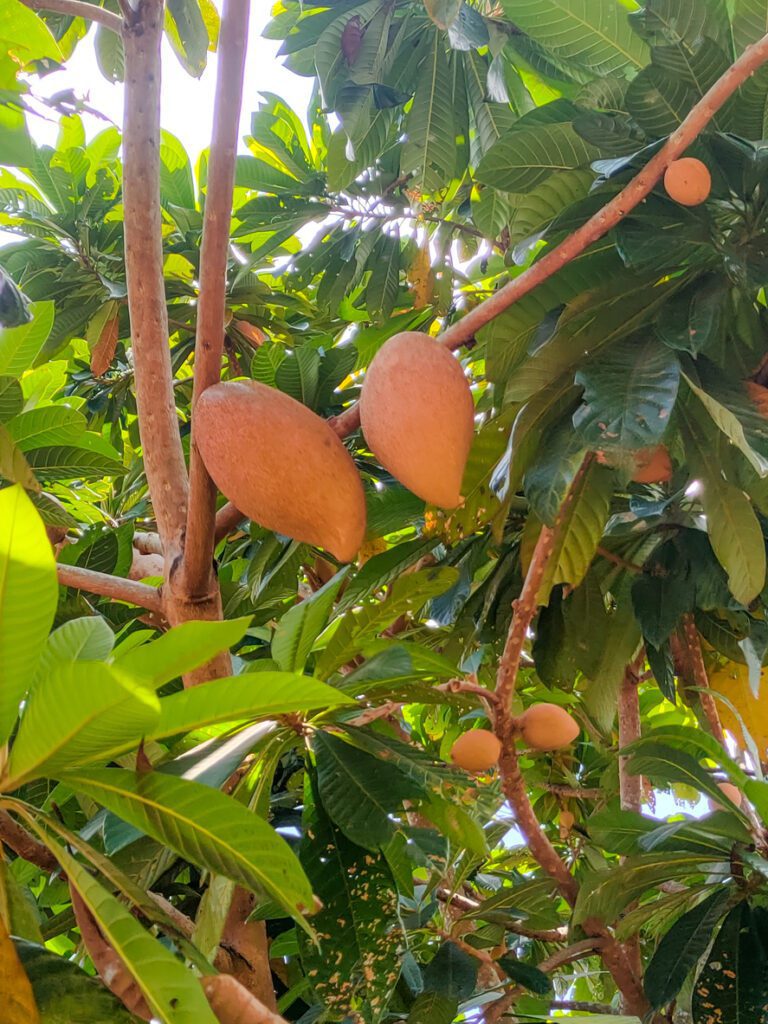What is the natural human diet? Like every species, humans have a species-specific diet. Today, in most cultures, humans are obviously cultural omnivores: we eat just about everything from nature that we can turn into edible matter through cooking and processing. But what is our natural, biologically appropriate diet? Humans, most likely, are frugivorous omnivores similar to chimpanzees. However, humans turned to cooking and food processing and suboptimal foods to survive in habitats that did not provide their natural food sources… and still are!
Our modern omnivorous diets mismatch our biology
Most humans eat an omnivorous diet today. Due to local food diversity and cooking culture, there are various – more or less healthy – diets. Most cultures include grains, meat and/or dairy, eggs, vegetables, fruits… and processed foods. A modern omnivorous diet!
Our anatomy and physiology, however, point toward humans being specialized fruit-eaters: frugivores, or frugivorous omnivores. Frugivorous apes, like chimpanzees, eat mainly fruits, nuts, greens, and small amounts of other food types and share nearly all characteristics related to diet with humans! Humans share a highly similar natural habitat, food preferences, and diet with our extended ape family.
Humans are, biologically, still adapted to tropical forested habitats and their abundance of tropical fruits, nuts, and other food sources: The human species-specific diet is highly frugivorous.

So, how did we end up adopting such a different feeding behavior today in modern society? Here is where our species’ history, natural habitat, and cultural adaptations come into the picture (see below).
Biology suggests that humans are frugivores!
What points toward humans being highly frugivorous (not exclusively fruits):
1. Genes: Humans are well adapted to a fruit diet
Humans have remarkable biological adaptations that they share with other high-fruit-eating primates. Examples are dental structure, optimized hands for fruit handling, specialized color vision, loss of vitamin C genes, and relatively high tolerance to seed toxins compared to other mammals. Unlike typical omnivores or carnivores, we do not possess distinct biological features for hunting, meat consumption, or digestion. Instead, we need tools like spears, knives, and fire to substitute for the “missing” claws, teeth, sprinting skills, etc. Read our full article on adaptations to fruit-eating and our article on “missing” carnivorous adaptations in humans.
2. Evolution: All great apes are highly frugivorous
Learning from chimpanzees gives us valuable insights about ourselves. We share many biological traits with our frugivorous closest relatives, the chimpanzees. Chimps specialize in ripe tropical fruit and do not regularly consume meat. To be precise, chimpanzees are frugivorous omnivores: they are able to digest both animal foods and plant foods. Their preferred and primary food source, however, is ripe tropical fruits. Around 70% generally, and sometimes exclusively fruit! Chimpanzees do eat small amounts of other foods, including animal foods, with little to no meat, depending on the individual and social groups.
3. Instincts: What foods are appealing, raw and unprocessed? Fruits!
Our instincts know what is appealing straight from nature – ripe, sweet, colorful fruits: Kids love raw, ripe fruits, but won’t eat raw meat, grains, or broccoli – nor would we ever feed them those foods raw. we know they would get in trouble. Our common sense and instinctual knowledge can answer the simple, but relevant question to define a species’ natural diet: what foods taste good when eating them unaltered straight from nature? Our smell and taste receptors are a reliable guide, if we don’t confuse them: only what is edible and tasty when raw, unprocessed, or unseasoned is suitable human food. Anything else is somewhat survival food. This does not mean we cannot eat other foods, as we clearly survive on different foods. We are, apparently, omnivores when it comes to survival foods, but biologically we are still specialized fruit-eaters. This only makes sense in the light of humans having originated in tropical forests – and still being a tropical species! (see below)
Why do humans eat an omnivorous diet today?
Biologically, humans are frugivores with diets high in fruit but have become cultural omnivores as a survival strategy.
“Through cultural innovation and changes in habitat and ecology, there have been a number of major dietary shifts in human evolution, including meat eating, cooking, and those associated with plant and animal domestication.”
Luca et al., 2010
“As a result of this cultural propensity to migrate to new areas, humans have adapted to differences in climate, altitude, and resource availability. Some of these adaptations to new environments are themselves cultural practices: for example, clothing and foot coverings that are suited to the climate, as well as novel tools and techniques for food acquisition and cultivation.”
Creanza & Feldman, 2016
Despite some local genetic adaptations that have occurred, humans are still adapted mainly to their original tropical habitat and natural food sources found in the tropics! It is important to note here that the evolutionary shift to open savannah habitats life has been corrected to humans being a forest species (Scerri et al., 2022) and coming from a highly frugivorous ancestry. Challenging this dogma significantly changes the idea of the past being a hunter-gathering species into a forest-dwelling, fruit-eating species.

We left tropical paradise… and had to cook to survive
Humans are primates and our biology is that of a tropical frugivore (like our closest relatives, the chimpanzees). But humans moved out of their original climatic zones. Migrating into colder climate zones forced humans to find new food sources, which included making non-foods edible by processing them through cooking.

Cooking turns “non-foods” into edible foods
Cooking often makes nutrients in inedible foods available, while reducing the amount of toxins. Together with seasoning it also turns the otherwise unappealing foods tasty. Most foods we eat today are actually toxic in their raw natural state! Most of them grow in temperate climates and have not evolved as foods with humans. Examples are grains, legumes, but also temperate vegetables and fruits before they were hybridized and selectively bred for edibility (read more here about food groups).
Read our in-depth article about the omnivorous hunter-gatherer theory versus the frugivore theory here.
Colder climates: not our home, not our foods, not the best health
The natural habitat of a species is where it can survive within environmental conditions such as climate and food availability. If manipulation of an environment (heating, clothing, growing crops, or processing local foods) is necessary to survive, then it is not the natural habitat of that species. This indicates, that physiology and anatomy have not evolved and adapted to the local conditions: humans are still adapted to tropical climates and their food sources.
Humans had no choice other than turning to suboptimal foods to survive in colder climates: more meat, insects, tubers and greens and later dairy and grains. We still do today – and it is not the best for our body’s integrity and health!
Turning to fallback foods is just what species do when their preferred food is not available! Frugivorous apes and monkeys turn to second-best foods when fruit (preferred food) is not abundant. However, unlike humans, animals cannot manipulate foods to an extent to turn inedible foods edible, and thus migration into another climatic zones is not an option. This also mean their survival foods do not deviate as much over time and thus are still species-appropriate:
“Across the range of the anthropoids, fruit is the major resource; in adapting to local conditions different species will extend that frugivorous preference in any number of directions – seeds and grasses (gelada), leaves (colobines and mountain gorillas), meat (chimpanzees, baboons), shellfish (chacma baboons), nuts (orangs, chimpanzees, uakari), and insects (chimpanzees, capuchins, squirrel monkeys) (Smuts et al. 1987). Such extensions might be in the direction of either lower quality or higher quality resources. However, the key element is that primates on the whole have a preference for relatively high quality resources.”
Craig Britton Stanford, Henry T. Bunn; Meat-Eating and Human Evolution; Oxford University Press, 2001, p.308
We are eating fallback diets today!
As we can see, there are survival foods and optimal foods for humans, too. This distinction certainly is not always a clear cut, however, it is obvious that foods, which must be processed to turn palatable or edible are “survival foods.” Those foods were important for humans to survive outside the tropics but are not optimal for health.
So what are fallback foods for humans? Everything that cannot be eaten raw and taste good is fallback food. If we start to think, this is about 80 % of what we eat today! Thus a cooked omnivore diet is a fallback diet – meaning most foods are not optimal for our biology! The further away we go from the tropics, the less we find optimal human foods in the diet. Read more about biological suitability of foods here.

Living and eating outside our original ecological niche come at a cost in health. Changes in environmental conditions (or migration into new areas) create selective pressure, which usually means decreased health!
But haven’t humans adapted biologically to colder climates and their new food sources?
Cultural vs. biological adaptation
Humans have managed to live in cold areas mainly due to cultural adaptations – not biological evolution!
“Through cultural innovation and changes in habitat and ecology, there have been a number of major dietary shifts in human evolution, including meat eating, cooking, and those associated with plant and animal domestication.”
Luca et al. 2010
Human diet changed with their migration out of the tropics. In colder, harsher areas, humans had to learn to survive outside their natural habitat, where food was more abundant and temperatures cozy. The migration out of those “optimal” habitats forced humans to live in environments to which their biology was (and still is) not well-adapted: humans have no major biological adaptations to cold climate nor cooked foods!
Consequently, humans were forced to manipulate the environment, by building infrastructure (housing, heating, clothing) and turning inedible foods into edible, nutritious, and tasty foods (cooking, seasoning, etc.). Our ancestors’ intelligence has enabled survival in areas outside the tropics. However, this is a behavioral (or cultural) adaptation to an unsuitable habitat, not an evolutionary response to cold stress through selection and changes in biological traits:

Unlike animals with particular cold adaptations (fur, hibernation) living in temperate and cold climatic zones, the human body is biologically not viable in that type of condition. Undoubtedly, some physical local adaptations in cold-indigenous people (such as skin color) have manifested, but human biology unmistakably shows that we are primarily adapted to warm climates and their food sources.

The human body can only survive in a warm environment with an abundance of nutritious, easy-to-forage foods because our bodies are still mainly adapted to tropical habitats. Most of us feel so good in the tropics, that we call the Caribbean “paradise -like”, as we walk with little clothing and enjoy beautiful local plants and also, improved health.
Where would you choose to live (or survive) without clothes, heating, and crops – I am guessing the answer is “in the tropics” for most of us.

Humans have developed cultural adaptation, that overcome limitations set by our biology within cold habitats.
Intelligence enables humans to manipulate their environment into more suitable, tropical conditions (i.e. warm housing, clothing and growing nutritious foods)
Eating foods that are not species-appropriate has health consequences
Humans have developed cultural adaptation, which allows overcoming the boundaries set by our biology. However, living in a habitat that is not optimal comes at the price of health. Today, humans grow up within a certain culture and local ecological conditions and thus learn how to prepare and eat local foods and dishes without questioning, “What am I actually eating?”.
This is the reason why most people eat a diet that does not suit human biology for the most part. We eat many foods that are not edible straight from nature in its raw state. Some foods are even poisonous raw and have to be prepared properly to be safe (read more here and here). The nutritional concept of a “balanced diet” can be seen as the attempt to eat an “optimal” survival diet – rather than our natural diet. A balanced diet has its place in human existence because we do not live in our natural habitat. By adopting a balanced diet, we aim to get the nutrients we need while keeping anti-nutrients in check. A balanced diet imitates our evolutionary diet in the best way possible. However, those foods are still not what we have adapted to eat and, thus, are not optimal for our health.
Let’s stop ignoring the signs of our frugivorous nature!
There are many signs and indications in comparative anatomy and evolution, that human biology strikingly resembles that of tropical high-fruit-eating primates. After all, they are our closest relatives. If “a frugivore” is defined as an individual or species, that is well-adapted to eating a diet very high in ripe fruits, then humans match that category impressively well! Also, we cannot neglect instinctual knowledge of our own species and define our human diet by what we would actually eat in the wild!
We sure can be categorized as omnivores, but mentioning the subcategory would do us a great favor: We are frugivorous omnivores!
Today’s omnivorous diets, found in most cultures around the world, are our survival fallback diet – not an optimal diet. Our biologically suitable diet resembles much more a chimpanzee’s diet: highly frugivorous, including high proportions of tropical fruits!
For health reasons, we should re-discover and strive towards our species-appropriate diet. This becomes especially relevant when we consider the current “war on sugar” that often – wrongfully – includes sweet fruits: keto diets, and high-meat diets are on the rise, despite a growing body of research on the subject pointing towards a negative health-outcome long-term.
References
- Did ripening fruit help hominids develop complex hands? Smithsonian Insider (available at https://insider.si.edu/2016/05/did-ripening-fruit-help-hominids-develop-complex-hands/). (link)
- O. Nevo et al., Frugivores and the evolution of Fruit Colour. Biology Letters. 14, 20180377 (2018). (link)
- G. Drouin, J.-R. Godin, B. Page, The genetics of vitamin C loss in vertebrates. Current Genomics. 12, 371–378 (2011), doi:10.2174/138920211796429736. (link)
- Luca, F., Perry, G.H. and Di Rienzo, A. (2010) ‘Evolutionary adaptations to dietary changes’, Annual Review of Nutrition, 30(1), pp. 291–314. doi:10.1146/annurev-nutr-080508-141048.
- N. Creanza, M. W. Feldman, Worldwide genetic and cultural change in human evolution. Current Opinion in Genetics & Development. 41, 85–92 (2016), doi:10.1016/j.gde.2016.08.006. (link)
- H. A. M. Daanen, W. D. Van Marken Lichtenbelt, Human whole body cold adaptation. Temperature. 3, 104–118 (2016), doi:10.1080/23328940.2015.1135688. (link)
- Scerri, E.M. et al. (2022) ‘Tropical forests in the deep human past’, Philosophical Transactions of the Royal Society B: Biological Sciences, 377(1849). doi:10.1098/rstb.2020.0500.
- Craig Britton Stanford, Henry T. Bunn; Meat-Eating and Human Evolution; Oxford University Press, 2001 (p.308) (link)
- Luca, F., Perry, G.H. and Di Rienzo, A. (2010) ‘Evolutionary adaptations to dietary changes’, Annual Review of Nutrition, 30(1), pp. 291–314. doi:10.1146/annurev-nutr-080508-141048.
Last updated on:


Add Comment